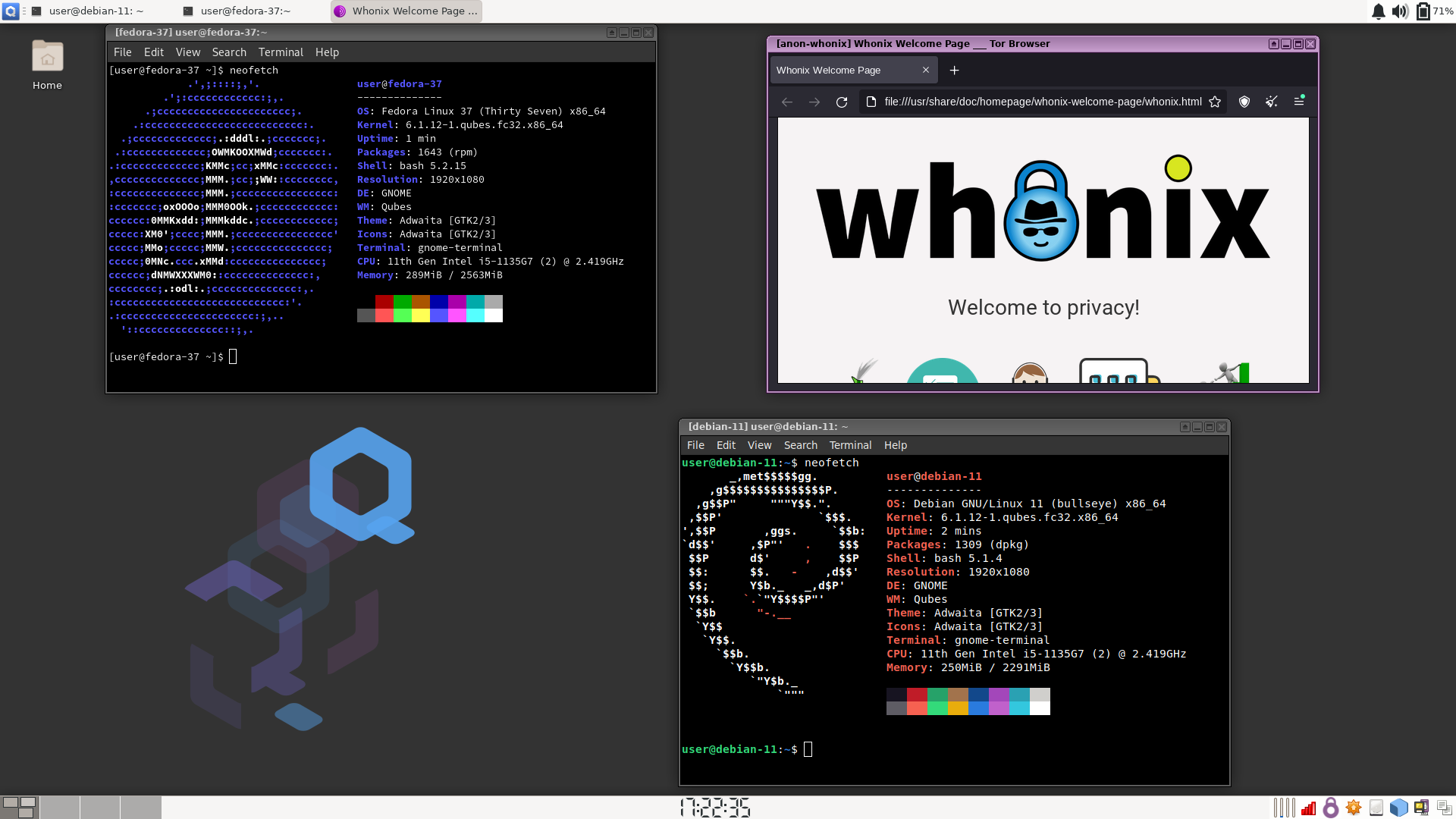Adventures in QubesOS (part 1)
Qubes Install
I’m mainly writing this so that I don’t forget. The installer for Redhat/Fedora/Qubes (Anaconda) doesn’t do well when you try to do an unusual partition scheme. How unusual? Lets go with:
- mdadm raid for everything
- luks encrypted root and swap
- provision an efi secure boot partition (Qubes doesn’t currently support this)
- use 4x 3TB disks
Shouldn’t be that hard, right? Debian’s installer handles this pretty well after all. If installing Redhat/Fedora, you need to boot into rescue mode and get to a shell. If installing Qubes, use a Fedora disk to do the above.
So, what we want is:
- A bootloader partition on all disks (installer will complain if you don’t have this on a GPT disk - I’m assuming this vs MBR)
- Secure boot partition on all disks (shouldn’t change much, so re-syncing data around shouldn’t be a big deal)
- Boot partition (raid1)
- LUKS partition (raid5)
Inside LUKS:
- LVM with:
- swap
- root
Lets begin:
1
2
3
4
5
6
7
8
# gdisk /dev/sda
Go into expert mode (x) and set the start block to 34 and exit expert mode (m)
Create the boot loader partition: n, start is 34 end is 2047, type is EF02 [1]
Create the EFI partition: n, default start, give it a hundred megs or so (EFI images can't be >40M - I did ~128M), type is EF00
Create the raid boot partition: n, default start, and give it 500-1024M, type FD00
Create user space partition: n, default start, to the end of the disk, type FD00
(There's a sort (s) option if you did these out of order and want the partition number relative to where it is physically on the disk)
Write the data: w
Note: this is documented more 1
Backup and copy the partition table:
1
2
# sgdisk --backup=table /dev/sda
# for i in b c d; do sgdisk --load-backup=table /dev/sd$i ; done
I then went back in to gdisk for each of the disks and changed the EFI partition’s name (#2 for me) to “ESB
Note: I don’t believe that creating the filesystem is required here as the installer wants to do that part for you, but I like to do it anyway.
Create the EFI filesystem:
# for i in a b c d; do mkfs.vfat “/dev/sd${i}2” ; done
Create the /boot raid1 and filesystem 2:
# mdadm –create /dev/md0 –level=1 –raid-devices=4 –metadata=0.9 /dev/sd[abcd]3
Notice the number for “raid-devices” and “abcd” if you have more or fewer disks. This shouldn’t take very long as long as you were sane with the space given to /boot.
Create /boot filesystem
# mkfs.ext3 /dev/md0
Create the raid for user space 2:
# mdadm –create /dev/md1 –level=5 –raid-devices=4 /dev/sd[abcd]4
And go to sleep, go to work, go for a very long dinner, watch a Star Wars marathon: this took >5 hours on my computer. If you’re curious (keep in mind: your screen will go to sleep and setterm didn’t seem to be on the rescue disk):
Progress
# watch cat /proc/mdstat
After it is finished building your second raid device, think up a nice long password (that you won’t forget) and …
Create and open a LUKS system (no reference):
1
2
# cryptsetup luksFormat /dev/md1
# cryptsetup luksOpen /dev/md1 main
Create LVM on top of that 2:
1
2
3
4
# pvcreate /dev/mapper/main
# vgcreate Main /dev/mapper/main
# lvcreate -L 32G Main -n swap
# lvcreat -L 20G Main -n dom0
Note: sizes may vary - this is what I did for Qubes (not sure I needed that much swap though). So if this is for a larger OS, 20G might not be what you want.
Create filesystems:
1
2
# mkfs.ext4 /dev/mapper/dom0
# mkswap /dev/mapper/swap
Close everything up:
1
2
3
4
# vgchange -a n Main
# cryptsetup luksClose main
# mdadm --stop /dev/md1
# mdadm --stop /dev/md0
Reboot into the Qubes (or Redhat/Fedora) installer. Assign “0” to /boot and ESB 1 to /boot/efi. Unlock LUKS, you’ll see your two LVM volumes - assign swap to be swap space and dom0 to be /. And install.
Links
- https://www.thomas-krenn.com/en/wiki/Mdadm_recovery_and_resync
References:
- https://wiki.archlinux.org/index.php/GRUB#GUID_Partition_Table_.28GPT.29_specific_instructions
- https://askubuntu.com/questions/660023/how-to-install-ubuntu-14-04-64-bit-with-a-dual-boot-raid-1-partition-on-an-uefi/660038
